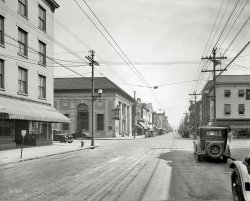
MAY CONTAIN NUTS

Search Shorpy
SHORPY ART

Framed or unframed, desk size to sofa size, printed by us in Arizona and Alabama since 2007. Explore now.
Join and Share
Ad-Free Shorpy
Shorpy is funded by you. Patreon contributors get an ad-free experience.
Learn more.

Recent comments
- Hudson’s Big Store
- Say what??
- Grapes?!
- A Beautiful Moment
- Such joy
- Bethune-Cookman University today...
- Yellow sky at morning
- Side Winder
- Air Quality?
- Sojourner Truth riot
- None were so blind(ed)
- The less famous sister
- Good ol' days?
- Rise and Fall
- Goo Goo Ga Joob
- Ticket Retention
- Not the only one
- Vagaries of War
- Killed by Amtrak
- Back to the Future
- Wanted --
- If you can't stand the light
- Centralized Traffic Control, I believe
- What's really happening
- Heckuva remote control!
- Sometimes — Things Go Bump!
- I SEE THE LIGHT
- Union Switch and Signal Company
- Get That Light Out Of My Eyes
- Eggs. Eggs. Eggs. The Egg Man is Here!
Member Photos
The Shorpy
Print Emporium
Print Emporium
Search Shorpy
Search results -- 30 results per page
- Extra Firm: 1905
- ... Barron Boyle -- a maker of paints and varnishes in Cincinnati . - Dave]
Thanks Dave, for the correction. Now I see it. I ... sign, however, may have been on any building in Cincinnati.
Trendsetter He's the first to demonstrate the "Lying Down ... Posted by Dave - 07/08/2014 - 1:09pm -
![Extra Firm: 1905 Circa 1905, location not specified. "Please go 'way and let me sleep." 8x10 inch dry plate glass negative, Detroit Publishing Company. View full size.
He must have drifted off quicklyA fetal tuck would have been a better position on that pier. He will wake up with sore kneecaps.
Don't laugh; this could be youI've seen railroaders curl up and doze in some pretty incredible situations. (I never was much good at that.) But that was in the modern era.
A typical work schedule for any "blue collar" employee (not "worker", a Bolshevik term) in the early 20th century was 10 or 12 hours Monday-Friday, and half day on Saturday. They gave you Sundays off and the two holidays were Christmas and July 4 with holiday pay optional. Also, in 1905 mechanical aids in work were just starting to show up on some jobs. Muscles were cheaper than machines.
This fellow worked a lot harder than most of us could do today. Spend a day with our friend here, and you could crash right along side of him.
A look at the shadow indicates midday, and no one is around but the "suit." This guy's sleeping through lunch break.
Barlow Boye Co.If we could locate the Barlow Boyle Co. (see sign on the building behind the bridge, we might have a location).
Nothing came up on Google or Ancestry.
[The sign says Barron Boyle -- a maker of paints and varnishes in Cincinnati. - Dave]
Thanks Dave, for the correction. Now I see it. I was also thinking "Barton," but your eyes are sharper. A. S. Boyle established a paint and glass company first located on West Court Street and then 428 Main Street. The advertising sign, however, may have been on any building in Cincinnati.
TrendsetterHe's the first to demonstrate the "Lying Down Game" where 105 years later people amuse themselves by assuming a stiff horizontal position in random places and then post it for everyone else's amusement.
http://www.lyingdowngame.net/
His Sleep Numberis B50.
Cat napI appreciate Old Buck's view of what is going on here. When I first looked at it, I thought this was a homeless man, and very sad, but it makes more sense that he would be a "blue collar" employee just taking a cat nap before going back to work. My grandfather, who was a sugar-beet farmer, would always lie down for twenty minutes, after dinner (the noon meal). Thankfully, Grandpa had a comfortable couch to lie down on, though!
His Sleep Number ...is B50. Notice the wooden stob protruding from the piling. Did they not use metal rebar back then?
C&O Railroad BridgeThis is the C&O Railroad Bridge in Cincinnati at the very northernmost end. The picture would be looking east, or upriver. If the picture were broader to the right you would be able to see the Roebling Suspension Bridge about a quarter mile upstream. The C&O Bridge was built in the late 1880's.
40 winks?That'll B50.
A little rest.My father worked for Con Edison in Brooklyn. When they worked on a site a tool trailer was dropped off, the workers reported direct, Dad got to wherever he had to be that day by trolley, bus and/or train.
One day after lunch he told his partner that he was going to close his eyes for ten minutes, and to wake him up at 12:30. He sat down with his back against a utility pole.
About 2:30, he woke up to find his partner laid out fast to sleep on the little grass strip between sidewalk and street.
They had some catching up to do, but didn't get caught.
AmazingThe poor fella must be totally exhausted. And the shoes? Maybe the pair at the foot of his bed would fit him. They seem to be in better condition. Great picture, Dave. Thanks.
BustedThat was me last Friday.
(The Gallery, Boats & Bridges, DPC, Railroads)](https://www.shorpy.com/files/images/4a17949a.thumbnail.jpg)
- Gunboat Diplomacy: 1905
- ... The two 2-stackers on the left are the USS Raleigh and Cincinnati (built 1894, 11x5 inch guns), the 2-stacker farthest away from the ... Posted by Dave - 08/13/2012 - 8:18pm -
![Gunboat Diplomacy: 1905 Venezuela circa 1900-1905. "American fleet at La Guaira." 8x10 inch dry plate glass negative, Detroit Publishing Company. View full size.
Ship IdentificationWell, I spent a little time shifting through a few websites to try to ID the various US warships in the harbor.
The ones I feel are positive about are the two three stackers. The one to the right is the USS Brooklyn. The one centered is the USS New York. These are both armored cruisers.
I would love to figure out what the two same class two stackers are to the left. There is another two stacker and a one stacker above the New York and are different classes.
Any guesses anyone??
The Quiet AmericanIsn't Teddy Roosevelt the guy that said "Walk softly, but carry a big stick"?
[T.R. was a firm believer in crepe soles! - Dave]
He sent the Fleet into Venezuela because the Brits and the Germans had set up a blockade of the country for, among other things, unpaid debts. He made sure that the Europeans left the region. Would that we had Teddy Roosevelt today.
President Teddy Roosevelt’s “Great White Fleet.”This appears to be a photo of America’s Great White Fleet during its around-the-world tour of 1907-1909. A voyage initiated by President Roosevelt to defuse the tensions of a near-war atmosphere between Japan and the US.
White Fleetit's easy to see where the term Great White Fleet would come from a couple of years later, when T.R. sent the navy around the world to show off America's newly established sea presence.
I wonder, how impressed were the Venezuelans to see these ships off the coast?
Steel NavyIt looks almost like Admiral George Dewey's Pacific Squadron from 1898, except a couple of the three-stackers appear to be battleships, or what passed for battleships back then. This photo was taken in Teddy Roosevelt's administration, and he certainly was not one to do things quietly.
BattleshipThe two 2-stackers on the left are the USS Raleigh and Cincinnati (built 1894, 11x5 inch guns), the 2-stacker farthest away from the camera is the USS Newark (1891, 12x6 guns), and the single-stacker is the USS Texas (1895, 2x12 cannons). The Raleigh was in the Battle of Manila Bay, and the Texas and Brooklyn were in the Battle of Santiago de Cuba.
HistoriansI am often impressed by the knowledge and resourcefulness of Shorpy commenters. To be able to start with a little information and expand it to the point of identification of the vessels and the reason they were there is beyond cool.
Imagine what could be accomplished if there was a way to electronically link the resources of the world through autonomous data access devices!
It might beThat the Navy has to go back to Venezuela again with that nitwit Chavez running things there.
Service ElsewhereThe USS Brooklyn was sent to Vladivostok prior to and during the Russian Revolution as part of an eight nation coalition to keep law and order. My grandfather served on the Brooklyn circa 1917-1918.
Another I did not know that.I did not know the Brooklyn made a trip to South America. My grandfather served on the USS Brooklyn in the Pacific circa 1917-18.They made port in the Philippines, China, Japan and Russia. I have several photographs and postcards he brought back.
Great White FleetThey went out with fuel for one way! TR told Congress that if they didn't cough up the money for fuel they wouldn't be home for Christmas! TR started the US Navy League after this cruise and we are still here!
(The Gallery, Boats & Bridges, DPC)](https://www.shorpy.com/files/images/4a05686a.thumbnail.jpg)
- Stuyvesant Dock Terminal: 1900
- ... shipments via [New Orleans] for Chicago, St. Louis, Cincinnati and all Western cities. The wharfage will be absolutely free to all ... Posted by Dave - 08/14/2012 - 4:01pm -
![Stuyvesant Dock Terminal: 1900 Louisiana circa 1900. "Stuyvesant elevators, docks, R.R. terminal at New Orleans." Detroit Publishing Company glass negative. View full size.
Harrison Line, LiverpoolAccording to a German/Weimar Cigarette card book "Lloyd Reederei-Flaggen der Welt-Handelsflotte" published by the Martin Brinkmann AG Zigarettenfabrik circa 1933, the flag represents the Harrison Line, Liverpool (Charente Steamship Co., Ltd.)
The flag is a red Maltese cross on a white background.
Working in:
England to the West Indies, Gulf ports and Mexico, Brazil, and Africa
Operating:
42 Cargo boats with small cabins
2 Passenger Freighters
Total Tonnage:
239,720
Honoring Mr. FishThe Stuyvesant Dock Terminal was named for Stuyvesant Fish (1851-1923), President of the Illinois Central Railroad, presumably because not even he was happy with the idea of calling it the Fish Dock Terminal. The opening of the terminal was a great leap forward for the New Orleans and Louisiana economies, and it was dedicated with "imposing ceremonies" conducted by Governor Murphy J. Foster and Mayor Walter C. Flower, on November 4, 1896, and with remarks by Mr. Fish on behalf of the railroad company.
According to the New York Times (10-26-1896), "The construction of these docks is the beginning of a great effort that the railroad will make to bring European shipments via [New Orleans] for Chicago, St. Louis, Cincinnati and all Western cities. The wharfage will be absolutely free to all steamers landing at the docks with interior freight for shipment by the Illinois Central Railroad, and such a saving in port charges, it is believed, will bring a great body of traffic this way."
Pristine tracks and locomotiveWhat really stands out to me in this photograph is the pristine condition of the yard tracks and the 0-6-0 that is hard at work. In 1900, stub switches were still in vogue in the South and West, as was unballasted track. The frog switches show that the Illinois Central was dedicated to being a truly modern railroad, as willc's research shows. I'm fascinated by the shiny boiler jacket and controls in the locomotive's cab, I suppose the same crew ran this locomotive daily or the engine terminal really spent some time on cleaning every night. I can assure that my local Canadian National/Illinois Central yard is being switched by a diesel that is no where as clean as this little teakettle!
And in 1905Disaster strikes.
History repeatingThe Stuyvesant Docks were on the Mississippi between Louisiana and Napoleon Avenues, stretching for twelve blocks before they burned in 1905. If you google that area today, you can still see the footprint of the massive railyard and the skeletal remains of the docks which burned again just a few years ago.
Backward CompatibillityThe slot and hole in the knuckle of the switcher's coupler are there to accommodate a link and pin, if a car with the just recently obsoleted (and dangerous) link and pin coupler needs to be moved. You can still see these coupler modifications on a few museum engines.
Dead or AliveThere isn't a man dead or alive who wouldn't jump up and sit on that tender next to the sign "Keep Off" because that's the way we are wired. Gotta love us…
Where in the world?Can anyone identify the flag atop the ship mast? It looks like a Maltese cross, but a quick search turned up no such flag.
Shipping Company House FlagsMost commercial shipping companies had house flags that were flown from the highest mast, at least in port. There were hundreds of designs, only a portion of which were recorded in registers. I didn't find a plausible match online for the flag seen here, but found several similar designs in the 1912 edition of "Lloyd's Book of House Flags and Funnels," a sample from which is seen here to illustrate the idea.
Colorized versionI colorized a major portion of this photo. Please look here and list any comments you may have. Thanks..
(The Gallery, DPC, New Orleans, Railroads)](https://www.shorpy.com/files/images/4a05057a.thumbnail.jpg)
- Watchers: 1938
- October 1938. Cincinnati, Ohio. "Watching the sesquicentennial parade go by." View full ... for the FSA.
Local Knowledge Being an architect in Cincinnati, I have some info on the buildings in the picture: The farthest in ...
BTW - Carew Tower is not the first structure in Cincinnati that served as a prototype for an important New York structure. The ... Posted by Dave - 07/16/2016 - 6:27pm -
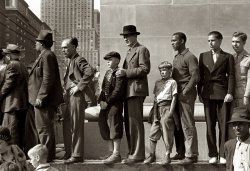
- Pistons Aplenty: 1942
- ... jeep or airplane engine parts. Aluminum Industries Inc., Cincinnati." Medium format nitrate negative by Alfred Palmer for the OWI. ... tank used by the Marines.
(The Gallery, Alfred Palmer, Cincinnati Photos, Factories, WW2) ... Posted by Dave - 07/29/2012 - 2:39pm -
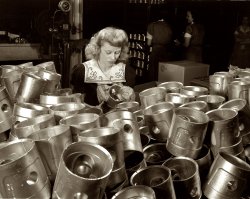
- Where's the Ticket Window?
- ... but I like to think she's lost and wandering around the Cincinnati Union Terminal service area looking for the ticket window. The ... Steel off Spring Grove Ave about a mile or so North of Cincinnati Union Terminal. CUT was relatively new when this photo was taken.
... Posted by Lost World - 09/23/2011 - 12:05am -
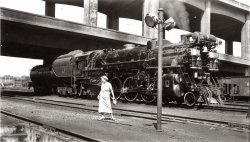
- Wash and Dry: 1943
- September 1943. Cincinnati, Ohio. "The children of Bernard Cochran, a Greyhound bus driver, ... you wanted to eat. Rural PA, mid-60's.
(The Gallery, Cincinnati Photos, Esther Bubley, Kids, Kitchens etc.) ... Posted by Dave - 02/26/2017 - 9:42pm -
![Wash and Dry: 1943 September 1943. Cincinnati, Ohio. "The children of Bernard Cochran, a Greyhound bus driver, doing dishes after Sunday dinner." Medium format negative by Esther Bubley for the Office of War Information. View full size.
Sunday dinnerWhen I was growing up in Nebraska in the 1960s, "dinner" was the big meal of the day, whenever it happened. Most often in the evening, but on Sundays and holidays like Thanksgiving and Christmas, dinner was the midday meal. On those days, and any time we had something smaller like soup and sandwiches or leftovers, the evening meal was called supper. Sunday dinner was usually something like pot roast with potatoes and carrots, which then provided leftovers to serve on Monday. The advantage of an oven roasted one-pot meal was, if our church service went long for some reason, dinner likely wouldn't be ruined. Sunday suppers at my house were often what Mom called a "cold plate". It consisted of various canned fruit like peaches and pears, vegetables like carrot and celery sticks, maybe scallions or green peppers, cottage cheese and cold salmon dumped out of a can. I did not pass this tradition along to my own children.
Telechron Clock Model 2H08, being 1943 it was probably made in the late 30's and is probably black.
Those clocks just never stop (with some occasional oil), I have two of them running at home and another at work, all pre-war.
The Mystery of the Pipettes, Solved?The "pipettes" bear a remarkable resemblance to gas valve handles.
[The question is about these structures. -tterrace]
As Emily Litella used to say, "Oh, that's very different. Never mind." =~)
Either Very Early Or Very Late DinnerThe wall clock indicates the time is 11:40!
[In a lot of places, "dinner" is what you might call lunch. Six hours later, it's time for supper. - Dave]
According to the clockThese folks had Sunday dinner either really early or really late.
No Aprons? These girls are washing and drying dishes in their Sunday "best" dresses, which their mom or grandma most likely made at home on the sewing machine (the skill of home sewers in those days was extraordinary). Since the photographer was there, they didn't put on the aprons they usually would have to do such a chore.
Love the Matchbox HolderWe had one of those in our kitchen. I had forgotten about them until seeing this. The open space on the side was so you could strike the match on the side of the box.
Great Stitching, PipettesVery nice stitching on the oldest's collar and button placket.
I'm assuming the piping on the wall is for the gas stove. So, what is the purpose of the "pipettes" on the front of each valve? Looks like tubing could be slipped on...for bunsen burners?
Better behaved than my brothers and IThese lovely young girls are: Irma Jane (11), Mary (9) and Sue Ann (7).
Mr Cochran's career spanned more than 30 years (1930 - 1960) with Greyhound (and possibly other companies).
BTW, We need a do-over in the 1930 elections. Bernard Cochran was double counted in the 1930 census. First, in Louisville, Jefferson, Kentucky (lodger, occupation Coach Driver, Motor Coach Transportation) and second, his hometown of Rising Sun, Ohio, Indiana (Taxi Driver, Bus Co).
Pipettes?Possibly moisture/condensate drains
"Pipettes"I can't positively identify the "pipettes" sticking out of the gas valves, but they could be for connecting portable gas appliances. There were once gas-heated clothes irons, toasters, etc. They had rubber hoses protected with a woven cotton jacket.
Such appliances would be "history" by the time of this photo, as the house has obviously been wired for electricity.
I believe "barb" is the proper name of the fitting on which one attaches a gas hose. I've not seen them called "pipettes."
About condensate drains - the old "coal gas" which preceded modern natural gas had two types of condensate. First, the generation and storage process left the gas saturated with water vapor. Second, the gas contained heavy compounds which would condense into a tarry substance. If you've ever seen an old iron cover marked "Gas Drip" in a street or sidewalk, this is a clean out of a trap designed to trap this tarry substance, which was a saleable product to the gas company.
A condensate drain must be at the lowest point of the piping, so I do not think these are drains.
At Our HouseSunday "Dinner" was at 1 PM, and was often an extended family gathering. Sunday Supper was "Free Fridge", whenever/whatever leftovers from the week were there when you wanted to eat. Rural PA, mid-60's.
(The Gallery, Cincinnati Photos, Esther Bubley, Kids, Kitchens etc.)](https://www.shorpy.com/files/images/SHORPY-8d33145a.thumbnail.jpg)
- Eden Park: 1906
- Cincinnati, Ohio, circa 1906. "Main entrance to Eden Park." 8x10 inch dry plate ... bridge were pretty well scraped away.
(The Gallery, Cincinnati Photos, DPC, Streetcars) ... Posted by Dave - 08/12/2012 - 3:05pm -
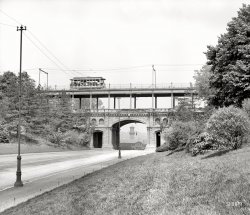
- Gasoline Alley: 1935
- December 1935. "Hamilton County, Ohio. Cincinnati slum dwellings." An alleyway view of the "Garage" sign seen in the ... Roads.
The Slums of Cincy Having grown up in Cincinnati, I think those slums were in the area of Eastern Avenue which ran ... right face Marengo Street.
(The Gallery, Carl Mydans, Cincinnati Photos) ... Posted by Dave - 07/16/2016 - 6:34pm -
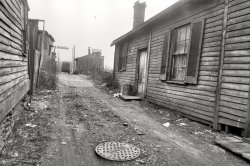
- Music Hall: 1906
- 1906. "Music Hall, Washington Park." Cincinnati Music Hall on Elm Street, completed in 1878. 8x10 inch dry plate ... German immigrants brought their culture to Cincinnati and settled in the area north of downtown. They built breweries and ... looking great It was built in 1878, and is the home of Cincinnati Symphony, Cincinnati Pops, and Cincinnati Opera, as well as the ... Posted by Dave - 07/08/2019 - 10:28am -
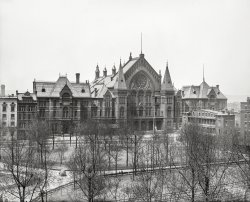
- Indiana Janes: 1908
- ... nothing. It was a good halfway point between Chicago & Cincinnati, and lots of other places. So it's not surprising to me that cotton ... Posted by Dave - 09/09/2011 - 12:12pm -
![Indiana Janes: 1908 August 1908. "Noon hour in an Indianapolis cotton mill. Witness, E.N. Clopper." View full size. Photograph and caption by Lewis Wickes Hine.
Satisfied?As another commenter mentioned, here's another Lewis Hine photo where the subjects are not glaring angrily at the photographer. Could it be that the workers were actually satisfied with their worksite? That doesn't fit in well with Hine's agenda that workers were abused by their employer. So, Hine could be balanced in the way he shows his subjects.
BTW, it looks like one could get pretty dirty working in a cotton mill (in Indianapolis, of all places!). Surprising, but what do I know.
Probably a FridayThey're Hoosiers. It's probably a Friday. Payday. Basketball game this evening. Life is good.
IndianapolisIndianapolis didn't get the nickname "Crossroads of America" for nothing. It was a good halfway point between Chicago & Cincinnati, and lots of other places. So it's not surprising to me that cotton would be shipped here for working.
Mill GirlsMy great-grandmother worked in a Virginia cotton mill as a teenager in the 1910s. In 1975 I interviewed her as part of my graduate thesis. One thing she kept repeating was what a "wonderful" job it was, and how "blessed" she was to be able to work there. When I asked about workplace conditions she said the only "workplace" the girls had before that was in the fields. "Crawling though [poop]." Maybe that's why they all look so happy.
Indiana Janes: 1908Hine didn't create those awful working conditions to fit his "agenda," he took the pictures to point out the awful working conditions. Perhaps these people are smiling because it's what's expected when someone points a camera at you, especially as this might be the only photograph that would be taken of you.
[ Conditions were not "awful." No one was making these girls work here. Lewis Hine took these pictures because that's what he was paid to do. His goal was ending child labor, not the employment of people these girls' age. - Dave]
South Carolina cotton millsI worked in 2 cotton mills in Greenville, SC in the 1970's. I worked pretty much every job in the Draper and Sulzer weave rooms. This was past the era when the mills built mill villages with houses, schools,baseball fields, and gyms for the employees but the people I worked with were happy, hard working people who liked their jobs. The biggest problem was the lack of a good retirement plan in the mills but then the employees were expected to plan and be prepared for their own retirement. I look back on my experience as a good one overall. The mill employees were like an extended family and took care of each other.
Who?I would love to know who these women and girls are. I have lived in Indianapolis my whole life, and have a lot of family history here.
(The Gallery, Factories, Indianapolis, Lewis Hine)](https://www.shorpy.com/files/images/01327u.thumbnail.jpg)
- Erie Canal: 1910
- ... Canal" I was in the 4th grade in 1950 in Cincinnati and our music teacher always had us sing "Erie Canal". I still know ... Posted by Dave - 09/29/2012 - 10:20am -
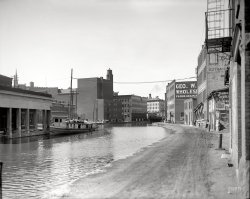
- Yeatman Alley: 1908
- ... where Harry McShane was injured. 314 Yeatman Alley, Cincinnati. View full size. Photo by Lewis Wickes Hine.
Yeatman Alley I live in Cincinnati and was trying to find out where this building was. I found an old ... Posted by Dave - 08/12/2012 - 3:32pm -
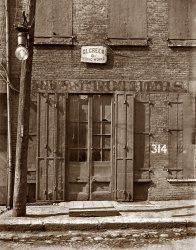
- Big Four: 1940
- ... for the New York Central's subsidiary, the Cleveland, Cincinnati, Chicago and St. Louis Railway, popularly called "The Big Four." The ... Big Four Cafe was, indeed, located next to the Cleveland, Cincinnati, Chicago and St Louis RR terminal at the intersection of Commercial ... Posted by Dave - 05/25/2012 - 7:58am -
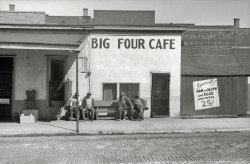
- Meanwhile, Back in Petoskey: 1900
- ... track. In some eras, through Pullmans were carried from Cincinnati and Chicago, dropping wealthy tourists close to their lake front ... Posted by Dave - 08/10/2012 - 12:05am -
![Meanwhile, Back in Petoskey: 1900 Petoskey, Michigan, circa 1901. "Grand Rapids & Indiana R.R. station." 8x10 inch dry plate glass negative, Detroit Publishing Company. View full size.
Always a first hereNever have seen a boat on a baggage carrier before.
Engine/TenderI'd like to see that engine and tender from the side; it appears that it's a commuter run (from the crowd on the platform) but it must run in reverse a lot because of the cow-catcher on the tender. No turn wye at either end of its run? Railfans - help?
Typical Trolley StopOk typical turn of the century trolley stop. two trolleys numerous interesting people, wait a second go back the sort of dapper guy in the foreground with the lapstrake skiff on a hand truck. Excuse me buddy but you can't take your fishing boat on the trolley even if you pay 2 fares.
I am really trying to figure this one out and just what is he doing with the boat at a trolley stop, we will probably never know.
[He's taking it (or sending it) somewhere else. This is, as noted in the caption, a railroad station, not a a trolley stop. - Dave]
Sorry Dave I was only looking at the Trolley that was probably bringing people to the train. But on another note, why is there a man sitting in the boat? is he part of the shipment?
Take a ride on the GR&IClick to embiggen.
It's a double enderIn this era about the only locomotives with big headlights on both ends were either switchers or double-enders. The catcher on the rear does indeed indicate this hog has regular assignment on a job where half of the trips are backward.
The earlier picture of Petoskey shows a train ready to leave here, probably with this very engine, running in reverse.
If you search an old GR&I timetable from this time, you'll find out where this train was going. It probably ran to some branch terminal that had no turn facilities, or it may have ended its run at some main line station that had no turn facility.
One of the most famous short line steam roads today, Pennsylvania's Strasburg Rail Road has been doing that from the start; there never have been turn facilities at Strasburg.
Next StopYou are right, the engine is designed to run tender first at the head of the train. The likely destination is Harbor Springs, which was served by a branch line diverging just north of Petoskey. Another depot photo shows a main line train on the track adjacent to the station, and a branch line train with a similar engine, tender first, on the next track. In some eras, through Pullmans were carried from Cincinnati and Chicago, dropping wealthy tourists close to their lake front hotels.
Tank EngineThe loco is a tank engine -- it has no separate tender. Both the coal bunker and water tank are carried on a rearward extension of the loco frame, in this case on a four-wheeled truck. It is a type of engine commonly but not always correctly referred to in the US as a "Forney." They were designed to be run safely at track speed in either direction without turning, making them well suited to suburban trains.
Railroad expansion plansCompare this one to the Petoskey depot view posted a few days earlier. Station platform is longer and has a new roof structure in 1908. New station platform surface. More tracks about the depot -- the expansion process is evident in this picture with rock wall stone on the flat cars. Extra track is to be added and the water spout seems to be missing in '08 shot -- as is the station semaphore signal. Engine number 4 is backing toward you in this view -- and may be the engine in the foreground in the 1908 view -- a number 4 seems to be on the forward headlight number board of the 4-4-0 in the '08 view though it is not clear. The engine cabs are a bit different -- back cab windows are at a higher level in the 'o8 photo. Rolling tail light shade is missing in this shot but evident in the '08 view.
Suburban Station at PetoskeyThis is the GR&I (later PRR) suburban station at Petoskey, which operated during the summer months for tourists headed out for the day at Walloon lake or Alanson. The steam engine pictured could operate in either direction (without turning on a wye track) to facilitate quick turnarounds. This suburban station was located about two blocks to the south from the main passenger station which still exists in 2011, without passenger train service.
"cowcatcher"?? Puleeze!!The proper term used by railroad personnel is "pilot".
The "station semaphore" is properly called "order boards" and the "water spout" was commonly called a "standpipe".
Possibly, in other parts of the world, these other terms may have been different, but "cowcather": never!
(The Gallery, DPC, Petoskey, Railroads)](https://www.shorpy.com/files/images/SHORPY_4a07903a.thumbnail.jpg)
- Fourth Street: 1910
- Cincinnati circa 1910. "Fourth Street east from Race." Close-up of this view ... rubber tires on the trolleys *smirk*
(The Gallery, Cincinnati Photos, DPC, Stores & Markets, Streetcars) ... Posted by Dave - 08/12/2012 - 3:01pm -
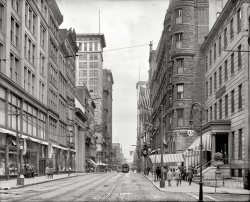
- Low-Rent: 1935
- ... Lightning conductor?
(The Gallery, Carl Mydans, Cincinnati Photos) ... Posted by Dave - 08/04/2014 - 6:21pm -
![Low-Rent: 1935 December 1935. "Typical squalid homes, Hamilton County, Ohio." 35mm nitrate negative by Carl Mydans for the Resettlement Administration. View full size.
Cheap HamThis is Ham Alley at Broad Street. It's the same tiny two-block neighborhood featured here.
Box in upstairs windowWhat is that?
[A refrigerator of sorts. Where you keep milk bottles in the winter. - Dave]
Little negativesI get spoiled by all the 8x10 images we see here. It's good to see 35mm for a change to help me remember to appreciate the large format images.
Ham AlleyWhere Cinci's bad actors end up after too many years of scenery-chewing?
Looking for TenantsThe previous ones hopped a freight car on the tracks next door in hopes of obtaining more humane living conditions.
Mystery rodWhat is that rod angling out from the eaves? Flagpole? Lightning conductor?
(The Gallery, Carl Mydans, Cincinnati Photos)](https://www.shorpy.com/files/images/SHORPY-8a00768a.thumbnail.jpg)
- Play-by-Play: 1924
- ... early 50s, Waite Hoyt, the local radio announcer for the Cincinnati Reds would do a play-by-play for out of town games based on ... Posted by Dave - 05/05/2013 - 4:37pm -
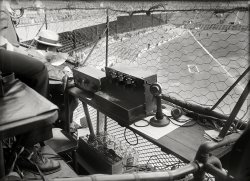
- The Halls of Academe: 1904
- Cincinnati, Ohio, circa 1904. "University of Cincinnati." McMicken Hall, flanked by his siblings Hanna Hall and Cunningham ... was of similar design to old McMicken. Designed by famed Cincinnati architect Harry Hake, the hall maintained a Georgian style, ... Posted by Dave - 07/02/2019 - 1:49pm -
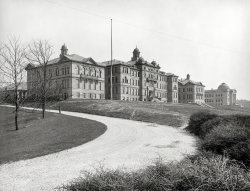
- Binary Banking: 1905
- Cincinnati circa 1905. "Lafayette and Franklin Banks, Third Street." With a ... size.
Located at 124 East Third Street An old Cincinnati City Directory lists the Franklin Bank at 124 E. Third St. Just ... I'm sure it's not a chicken in the middle of downtown Cincinnati but, that sure looks like one at the bank's door. Perhaps she puts ... Posted by Dave - 05/16/2016 - 3:19pm -
![Binary Banking: 1905 Cincinnati circa 1905. "Lafayette and Franklin Banks, Third Street." With a painter and a window-washer in supporting roles. 8x10 glass negative. View full size.
Located at 124 East Third StreetAn old Cincinnati City Directory lists the Franklin Bank at 124 E. Third St. Just about everything on Third Street has been replaced with new modern buildings. Here is an old map section of this area that clearly shows the location and interior floor plan of the two banks in the structure. Bank Alley to the left of the bank appears to have been renamed "Berning (Bank) Alley" on the map and the alley still exists on Google maps today and it is now called Berning Place. Everything shown from Berning Alley to the corner of 3rd and Main is now a parking garage.
Perilous Window Washer & The Banking ChickenBefore anyone complains that there is no window washer, I had to look long and hard to find him. He is death-defyingly way up in the top of the picture.
Also, I'm sure it's not a chicken in the middle of downtown Cincinnati but, that sure looks like one at the bank's door. Perhaps she puts all her eggs in one bank.
[I think the "chicken" is a boot jack. -tterrace]
How fascinatingthat there was a scenery painting studio in the second floor of the bank building, with all that great daylight from the glass dome. TTerrace, I think that the "chicken" is actually a boot scraper, to get mud and horse dookey off before going indoors. A boot jack is to help remove your boot from your foot.
[You're probably right. -tterrace]
(The Gallery, Cincinnati Photos, DPC)](https://www.shorpy.com/files/images/SHORPY-4a11627a.thumbnail.jpg)
- Dearborn Reds: 1952
- ... if that name was used elsewhere or if it was just another Cincinnati expression or something unique that my mother came up with.
In ... Posted by Dave - 01/15/2021 - 2:07pm -
![Dearborn Reds: 1952 "1952 Ford Customline Tudor Sedan." As opposed to the "Fordor" sedan, which had two Mordors. Color transparency from the Ford Motor Co. photographic archives. View full size.
Lady you're gonna hafta move this thing!Coach is giving his star halfback Biff enough time to arrange a date with Suzy Cheerleader but his patience is wearing thin as practice has already started.
Coral Flame RedIt's amazing how many color choices you used to get on a new car. Basically a color palette to choose from and each with its own unique name. This '52 color is Coral Flame, later to be re-named Torch Red. Another example is below.
A Very Red Car, ComradeThis '52 Ford reminds me of Soviet cars of the late-'50s through '70s.
Pictured: the 1957 Volga M21V.
All New for '52!How often do you hear those puff words in connection with a new car model? However, for 1952 Ford wasn't kidding! An all new body to begin with, and if it had the six, which this one obviously doesn't, it would be an all new overhead design. It also had three features that would become ubiquitous on almost all cars during the coming years. It had suspended brake and clutch pedals instead of the old style that went through the floorboard. Also a step-on emergency brake with Buick being the only other make to offer it. And I believe it was also the first make to place the fuel filler behind the license plate, making it able to use either side of a gas pump.
Made the year I was bornIn the mid-'60s my best friend's dad had one similar to this. By that time it had a fairly substantial hole in the floor on the front passenger side where it had rusted out. Big enough that we could look down and see the road whizzing by under us. The front seat anchor was also broken so the entire seat would tilt back if you pushed on it. It's a miracle we weren't asphyxiated or killed in that thing! Seems to me that a 10-year-old car today is not likely to be in such terrible condition.
[My dad had a 1951 Ford with a hole in the same place! One day on the way to school we went around a corner and the door flew open and he had to grab my arm to keep me from falling out. Right after that he traded it for a new 1966 Galaxie. - Dave]
And one does not simply walk into MordorWhy does a chicken coop have two doors? Because if it had four doors, it would be a chicken sedan.
Time to get back to practice, kidsVery professional shot. But it's interesting to see what appears to be a wedding ring on the football player's hand -- he better be careful with the flirting. Fortunately, his coach is there keeping an eye on things, though he's probably a bit annoyed that this car is out on the field.
Why did they name it after Henry VIIIWhen I was in seventh grade, the Ford dealership was diagonally across the street from school. I would wander around the showroom admiring all the new 1961 Fords. I particularly liked the Galaxie Starliner. I was always confused as to why they named so many cars after the English House of Tudor. I'm not going to say how long it took me to figure out what was really being said. The reason being of course that as such a recent immigrant from Britain, I pronounced it the British way, TYOO-der, not "two door," like Americans.
Rear ViewYou can check out a rear view of the same basic model a few years later on this Shorpy photo.
Most of these cars from that era before air conditioning was common have a small opening front corner window, popularly known as a "no draft".
["Vent wings" in the Lower 48. - Dave]
Door LatchesDad took us to the introduction of the 1952 Fords at Times Square Motors in Erie, PA. The pushbutton latches were right at my eye-level and I was proud to grab his sleeve and say "Hey, Dad! Look at this!"
Vent Wings and AerodynamicsIn our house my mother called them "Cozy Wings." Not sure if that name was used elsewhere or if it was just another Cincinnati expression or something unique that my mother came up with.
In addition to ventilation the vent wings served a very useful aerodynamic purpose.
With today's "vent wingless" cars if you have your side window open and are cruising on the highway above about 45 mph the wind passing by the window causes an annoying throbbing sound. Vent wings were also "throbbing sound minimizers". Try it using your hand as a pseudo vent wing and note the reduction.
Our Take in SoCal“Wind Wings”
(Kodachromes, Cars, Trucks, Buses, Sports)](https://www.shorpy.com/files/images/SHORPY-1952-Ford-Customline-1A.thumbnail.jpg)
- Fountain Square: 1907
- Circa 1907. "Fountain Square, Cincinnati." Dry goods, dentists and the Western Tray Factory. 8x10 inch glass ... feet or so (it appears in the opening credits of "WKRP in Cincinnati"). The tall building on the right, with "New York Life" in the ... of Fifth and Vine, its final location.
(The Gallery, Cincinnati Photos, DPC, Streetcars) ... Posted by Dave - 11/22/2015 - 10:16am -
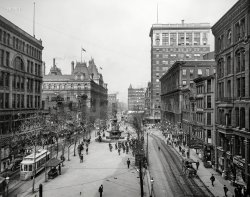
- Urban Ohio: 1907
- Cincinnati again circa 1907. "Fourth Street west from Main." The WURLITZER sign ... Return! Last weekend streetcars returned to Cincinnati and topped 20,000 riders!
Two trolley poles. Note the two trolley poles on the trolley. Cincinnati would not allow electric cars to pick up their ground through the ... Posted by Dave - 09/23/2016 - 10:53am -
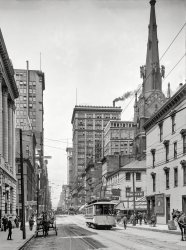
- Orange Crush: 1926
- ... for "Cincinnata," as some Buckeyes referred to Cincinnati.
The Orange Crush beverage I recall was late 1940s vintage in ... Posted by Dave - 09/11/2011 - 12:34pm -
![Orange Crush: 1926 Washington, D.C., 1926. "Industrial Exposition. Orange Crush." A literally moldy oldie. View full size. National Photo Company Collection glass negative. If you're a fan of these Washington Industrial Expo photos, stay tuned.
.05I'll have an orange crush for 5 cents please.
Lemon and LimeLooking in the background, they had lemon and lime crush too. Huh, I never knew that.
My PalDon't know if these orange drinks were nationally distributed or regional but having spent my first 24 years in Connecticut, I also loved Pal, a non-carbonated orangeade. Crush was good too, but carbonated. Much later there was a grape Crush and also a Nehi Grape. The Northeast also had birch beer which I have not found anywhere else around the USA. There was dark birchbeer, white birchbeer and red birchbeer, a very refreshing cold drink, especially good with Connecticut pizza. (Come to think of it, I don't think I have ever seen a white birch tree since I left Ct.) Everything was so much tastier in those days, maybe my tastebuds have died. Thanks for the wonderful "blasts from the past", I love them all.
Trade ExpoI wonder if they took these just before the doors opened. They all look curiously void of customers compared to trade expos I've visited.
Drink UpI can understand the Lemon and Lime Crush. But the Schmidt's... is that the non-alcholic version made for prohibition era markets? I can't find a good picture of the label of that brew.
I've got my spine ...I'd imagine most site visitors between the ages of 30 and 50 now have the same R.E.M. song stuck in their head.
I was pleased to learn that the drink is still made, though not as widely available as it once was. It had been around for about 10 years when this picture was taken; Lemon and Lime Crush were newer introductions.
Good GrapePrevious commenter said grape was invented years later, but there it is on the sign behind the balloons.
[He was talking about Nehi Grape. There was also Nu-Grape, seen here and here. - Dave]
Counter GirlAt expos today, they usually use models. This girl looks a little like Jerri Blank.
Foxon Park Birch BeerFoxon Park in East Haven still makes white birch beer and it's still great. They use real sugar, not high fructose corn syrup. You can order it from their website:
http://www.foxonpark.com/
I'm sure a bottle will show your taste buds to be fine.They also make Iron Brew, which some people compare to Dr. Pepper. If you like Moxie, you'll like Iron Brew.
Old memoriesMy first job in the early 60's was making Orange Crush for a local distributor in Fall River, Mass. Delco Bottling. I remember the time we put root beer bottle caps on the Orange Crush. OOPS!
Mom & Pop pop"Cinti" -- never heard of that particular abbreviation for "Cincinnata," as some Buckeyes referred to Cincinnati.
The Orange Crush beverage I recall was late 1940s vintage in the ripply brown bottles. It contained real orange juice and pulp with a lot less sugar.
At our local "mom & pop" convenience store you leaned over the water-filled cooler, lifted one of the heavy double doors, plunged your hand into the cold water filled with various brands of pop and wiped the dripping bottle on an equally soaking wet cloth.
Then you put your selection in the bottle-top remover on the cooler and snapped off the cap, which dropped down into a receptacle that the local boys were only too happy to empty. We'd remove the cork liners, place the metal part on the outside of our T-shirts and push the cork liner from the inside our T's back into the back of the cap.
This gave us instant "badges" looking a lot like military medals and we'd see how many we could get on one shirt. It was great for playing soldier! The caps were also scratchy against our bare skin.
We also collected paper milk bottle caps. There were always a bunch of different dairies who delivered door-to-door with their horse drawn wagons. But that's a whole other pastime.
We seldom had money to buy baseball card bubble gum packs. These were the days of very low tech, no-cost activities we neighborhood kids would do during summer vacations.
We never seemed to get bored.
(The Gallery, D.C., Natl Photo)](https://www.shorpy.com/files/images/32274u.thumbnail.jpg)
- Sweet Street: 1907
- Circa 1907. "Fourth Street, Cincinnati, Ohio." Where the brands vying for your trade include Mullane and ... gauge of 4 feet 8.5 inches.
Two trolley poles? Cincinnati was one of a handful of cities that forbade their streetcar lines ...
http://www.cincinnatimagazine.com/citywiseblog/cincinnati-vintage-candy-...
A Florida candy company uses a machine from ... Posted by Dave - 09/23/2016 - 12:03am -
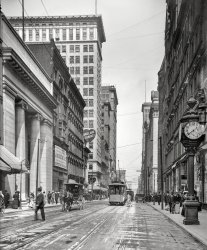
- Neighborhood Watch: 1935
- ... a while to figure out, but I was able to identify this as Cincinnati's Walnut Hills neighborhood. The buildings at the extreme top right ... lot of individual touches.
(The Gallery, Carl Mydans, Cincinnati Photos) ... Posted by Dave - 04/23/2015 - 11:57am -
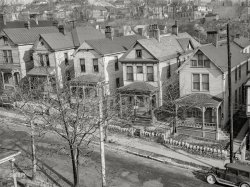
- Gritty Cincy: 1935
- December 1935. "Hamilton County, Ohio. Cincinnati slum dwellings." Close-up of the houses seen in yesterday's post. ... or used by another family.
(The Gallery, Carl Mydans, Cincinnati Photos) ... Posted by Dave - 08/08/2011 - 10:26pm -
![Gritty Cincy: 1935 December 1935. "Hamilton County, Ohio. Cincinnati slum dwellings." Close-up of the houses seen in yesterday's post. Note the railcar in the background. 35mm negative by Carl Mydans for the Resettlement Administration. View full size.
Both sides of the tracksThat really is the wrong side of the tracks. Wonder who lived in the aforementioned castle up the hill.
[As it turns out, college students. See the comments here. - Dave]
Why...is there a stove lying on its side in the foreground? I would assume that ANYTHING in this neighborhood would be scooped up to sell for scrap or used by another family.
(The Gallery, Carl Mydans, Cincinnati Photos)](https://www.shorpy.com/files/images/8a00729a.thumbnail.jpg)
- Municipal Palace: 1907
- Cincinnati circa 1907. "Federal Building (Custom House and Post Office)." ...
Photo shows clearly the double overhead peculiar to the Cincinnati electric streetcar system; all of the other hundreds of trolley ... helped prevent wheel wear and noise.
(The Gallery, Cincinnati Photos, DPC, Streetcars) ... Posted by Dave - 03/29/2017 - 12:04pm -
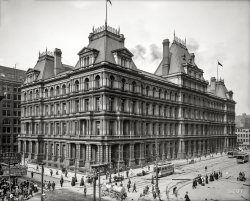
- Gold Coin Mine: 1900
- ... The orig. troupe, under white proprietorship, played Cincinnati, OH, in May 1899 with a roster that included the Blackstone Quartet, ... Posted by Dave - 07/20/2012 - 1:38pm -
![Gold Coin Mine: 1900 Circa 1900. "Victor, Colorado. Gold Coin Mine." 8x10 inch dry plate glass negative, Detroit Publishing Company. View full size.
Coontown 400Just to the right of the building with the painted advertisement for "Elector" cigars, you can see a fence plastered with advertising for "Coontown 400", a variety troupe.
Whether it is the same troupe as below or not, I'm not sure. Perhaps they had already made bookings and then went bust. I couldn't find another revue by the same name. Although there is a cartoon book called "Coontown's 400" by E.W. Kemble, published in 1899, "with what we would today consider racist portrayals of "darkies".
"Coontown Four Hundred (also Coontown 400). Variety troupe, active at the turn of the century, which underwent a number of changes of name and management. The orig. troupe, under white proprietorship, played Cincinnati, OH, in May 1899 with a roster that included the Blackstone Quartet, Tom Brown, Edna Alexander, Ida Forsyne, Whitney and Tutt, and others; it then disbanded in Nov. of the same year for non-payment of salaries. Management was taken over by Howard McCarver in September 1901, and the name was changed to A Honolulu Coon Co..." "The African American theatre directory, 1816-1960"
"One of Arthur Marshall's anecdotes has Marshall and [Scott] Hayden both living with the Joplins. This had to have been in late 1902 or 1903, for Marshall had been on a two-year tour with the Dan McCabe's Coontown 400 until the fall of 1902. It was probably at the end of the tour that he moved in with the Joplins, for Dan McCane in December was in St. Louis and visited the Joplins" "King of Ragtime: Scott Joplin and his era"
One Hundred and thirteen polesAmazing. Telephone, telegraph, electric, I counted one hundred and three poles before I started seeing double. Then spotted several more. You could spend days studying the histories of technology, architecture, construction, transportation, manufacturing, marketing and more, just in this single photograph. I love it. Still haven't found Waldo, however.
What a Project!Super photo from which to fashion a scratch built model railroading site in one's basement. So much going on, track at several different levels, limitless building designs, and a background that leads into a diorama-like mountain scenic.
I'd put a flag on that pole next to the smokestack, however.
Victor RR Depot - then and nowFrom the building with the Elector Cigars sign, follow that street to the right and where it ends you will find the Victor Midland RR Depot. The depot's overhanging roof casts dark shadows on the side of the building, which was the center of much activity at the time this photo was taken. The depot still stands today in relative isolation and four photos of it taken in 2006 can be viewed on this page. The eastern end of the depot is closest to the camera in the 1900 photo, which looks to the southwest.
August 1899 FireA large part of Victor burned to the ground in 1899, and it is said that most of the town was rebuilt in six months of brick instead of wood. It does seem as though there is a lot of "new construction" around!
(The Gallery, Mining, Railroads, W.H. Jackson)](https://www.shorpy.com/files/images/4a09194a.thumbnail.jpg)
- King Street: 1926
- ... as used by trolleybuses and a few tram systems like Cincinnati.
Upward Mobility I always look for the Model T Fords. Only a ... electrical capacity without stringing feeder cables. Cincinnati had them for lines within the city limits. Some lines used double ... Posted by Dave - 04/13/2011 - 12:56pm -
